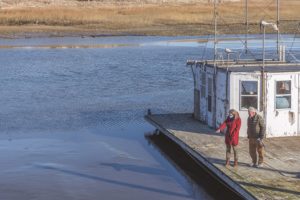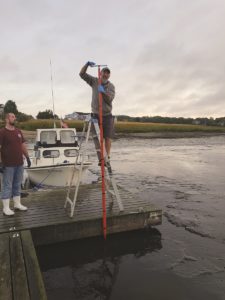WELLFLEET — Agnes Mittermayr, a marine ecologist at the Center for Coastal Studies (CCS) in Provincetown, has coined a new term to describe the dark, sludgy material that fills Wellfleet Harbor: “black custard.”
“Initially, everyone called it ‘mayo,’ ” she said.

Agnes Mittermayr of the Center for Coastal Studies and John Riehl, chair of the Wellfleet Natural Resources Advisory Board, assess the harbor’s black custard — organic matter formerly called
black mayonnaise. Our story on why the name change matters is on page 6. (Photo Nancy Bloom)
“Black mayonnaise” is an unofficial term used to describe toxic, human-made sedimentary material. The New York Times referred to it in a November article on the dredging of the Gowanus Canal in Brooklyn.
But a CCS study funded by the Wellfleet Natural Resources Advisory Board (NRAB) and published last May found the “gooey, black, and smelly substance” to be rich in decomposing marine plants.
“It is not toxic,” said Mittermayr. “I would put my hand in it.”
Since the material found in Wellfleet Harbor did not contain human waste, Mittermayr said, they needed a different term to distinguish it from the Gowanus-type toxic mayonnaise. And so, “black custard” was born, as stated in the report, “for lack of a better word.”

The CCS study was in the works for a while. The town agreed to fund it at a 2016 town meeting. The purpose was to better understand dredge “spoils,” now called black custard, in the north marina channel of the harbor — both what it is and how it moves. The hope is that the study will help find an alternative to dredging.
As reported by the Independent, the Army Corps of Engineers began the first phase of a three-year dredging project in Wellfleet Harbor this past fall, removing 192,000 cubic yards of black custard from the harbor floor and depositing it in the middle of Cape Cod Bay. The project is expected to cost $12.5 million, split between the town and the federal government.
On Jan. 12, the select board voted to accept and post a draft of the NRAB’s third Harbor Management Plan, which includes a goal to “replace dredging in a way that allows local control and lower costs needed for harbor dredging.”
John Riehl, chair of the NRAB, says that, now that the CCS study is complete, there is a “real possibility of bypassing a future dredging by doing some local engineering to determine how the black custard can be moved from the north channel of the marina out into a pathway down Mayo Creek.”
The CCS study found that black custard exists primarily in and around the town pier. It reaches depths of 8 feet south of the pier and 12 feet in the middle of the harbor basin.
Scientists asked members of the shellfishing community to mark locations on a map where they suspected there might be black custard (then referred to as “mayo”). The scientists took samples from those areas, including near “the Gut,” the narrow strip of land connecting Chequessett Neck to Great Island.
Getting those samples, however, was no easy feat. Steve Swain, owner of the Frying Pan Gallery, worked with the scientists to construct an auger for collecting core samples. “He was a real MacGyver,” said Mittermayr.
There was an obvious difference between the samples, scientists found. Those from the Gut contained sand-size particles, whereas those from the pier were silt-size. Scientists found that fine-grained sediments tend to flocculate or “come together and form into small clumps and masses,” especially with slow tidal currents, though the exact cause is unknown.

The black custard was anoxic, or low in oxygen, said Mittermayr. To test the organic content of the samples, they were placed in a special drying oven. This created an unexpected result. When cooked, Mittermayr said, “the sediment started to smell like baked potatoes.” It was found to be made mostly of macroalgae and other aquatic organisms.
Now, the NRAB is looking into how the black custard can be coaxed to move through the creeks and into the marshes. One way, said Riehl, would be to open Mayo Creek, a plan currently in the permitting phase. Another, he said, would be to pump the material closer to the creek.
Tidal restrictions, such as the Mayo Creek dike, prevent sediment from reaching the marshes, where it should naturally end up. Instead, sediment gets trapped in the north marina channel, said Riehl. When tides bring sediment into the marshes, it contributes to accretion, or upward growth, and helps the marshland respond to sea level rise.
There are currently no plans to rename Mayo Creek “Custard Creek.”



